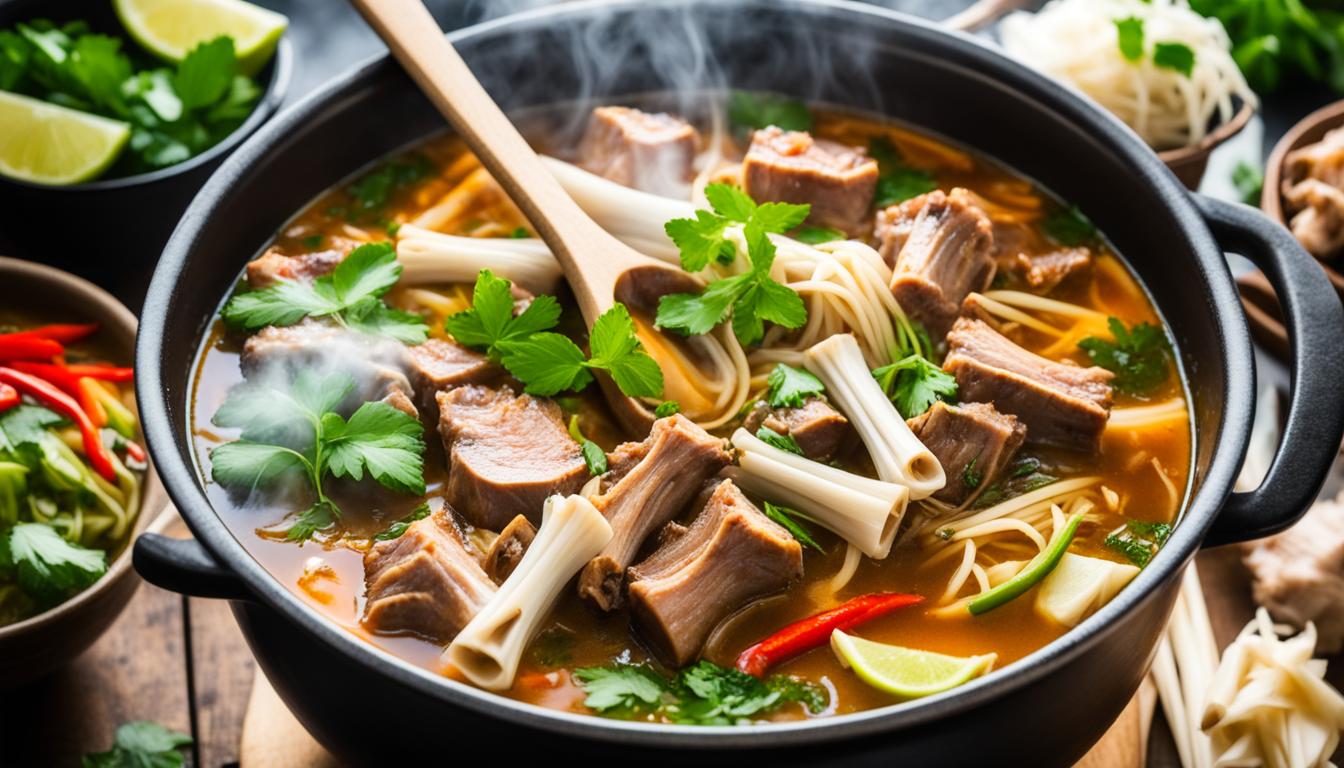Are you a lover of Thai cuisine and want to take your homemade soups to the next level? Discover the secret to creating flavorful and authentic Thai pork stock that will elevate your dishes to new heights. Say goodbye to store-bought stock and embrace the rich flavors of homemade Thai pork stock.
Thai cuisine is renowned for its bold and aromatic flavors, and a good stock is the foundation of many traditional dishes. In Thailand, pork stock is the go-to choice for creating hearty soups that are packed with flavor. From classic Tom Yum to comforting noodle soups, this versatile stock is a must-have in any Thai kitchen.
In this article, we will guide you through the process of making homemade Thai pork stock from scratch. We’ll share the essential ingredients and techniques that will help you achieve a rich and authentic flavor profile. Get ready to impress your family and friends with your culinary prowess!
Key Takeaways:
- Creating a good stock is crucial in Thai cuisine, and pork stock is the preferred choice in Thailand.
- The main ingredients for homemade Thai pork stock include pork bones, lemongrass, garlic, cilantro roots, daikon or onion, and white peppercorns.
- Simmering the bones with aromatics for an extended period allows the flavors to intensify and develop.
- Straining and cooling the stock help remove any impurities and excess fat.
- Homemade Thai pork stock can be used immediately or stored in the freezer for future use.
Homemade Thai Pork Stock for Authentic Thai Dishes
Thai pork stock is the most commonly used stock in Thai cuisine, particularly in noodle soups. It is the base for many traditional Thai dishes. The use of pork backbone or neck bones provides flavor and body to the stock. Blanching the bones and washing them before simmering helps create a clear stock. The addition of aromatics such as lemongrass, garlic, cilantro roots, and white peppercorns enhances the flavor profile of the stock. Straining and cooling the stock allows for easy removal of any fat on the surface. The stock can be refrigerated for up to a week or frozen for up to six months.
If you’re looking for an authentic Thai pork broth recipe, making your own stock is essential. This traditional Thai pork stock is rich in flavor and adds depth to your dishes. Follow this recipe to create a homemade Thai pork bone broth that will elevate your Thai cooking.
Ingredients:
- 2 pounds pork backbone or neck bones
- 4 stalks lemongrass, smashed
- 8 cloves garlic
- 4 cilantro roots
- 1 tablespoon white peppercorns
Instructions:
- Blanch the pork bones in boiling water for 5 minutes to remove impurities. Drain and rinse the bones.
- In a large pot, combine the blanched pork bones, lemongrass, garlic, cilantro roots, and white peppercorns.
- Add enough water to cover the ingredients and bring to a boil.
- Reduce the heat to low and simmer uncovered for at least 2 hours, skimming off any foam that forms on the surface.
- After simmering, strain the stock through a fine-mesh sieve into a large bowl or container.
- Allow the stock to cool completely, then refrigerate or freeze for future use.
Tips and Variations for Making Thai Pork Stock
When making Thai pork stock, it’s important to use fresh ingredients and adjust the seasoning according to your taste. The quality of the ingredients will significantly impact the final flavor of your stock, so try to source high-quality pork bones and aromatic herbs.
For a traditional Thai pork stock, follow the recipe provided in Section 1, using ingredients like lemongrass, garlic, cilantro roots, and white peppercorns. However, don’t be afraid to experiment and add your own twist to the recipe. You can try adding other herbs and spices like galangal or ginger for an extra kick of flavor.
If you’re looking for an easy Thai pork stock recipe, consider using a pressure cooker like an Instant Pot. This will significantly shorten the cooking time while still allowing you to achieve a rich and flavorful stock. Just make sure to adjust the cooking time and follow the manufacturer’s instructions for using the pressure cooker.
In case you can’t find cilantro roots, don’t worry! Tender cilantro stems can be used as a substitute. The stems still have a similar flavor profile and will add a fresh and aromatic note to your stock.
Remember, the beauty of making Thai pork stock lies in the variety of flavors you can create. Feel free to experiment with different ratios of ingredients or even add other ingredients like mushrooms or dried shrimp to enhance the complexity of your stock.
So go ahead, follow the basic recipe for a traditional Thai pork stock, or adapt it to your preferences. With a little bit of creativity and exploration, you’ll be able to create a personalized version of this beloved Thai staple that will elevate your soups and dishes to a whole new level.
